AMD Kaveri Review: A8-7600 and A10-7850K Tested
by Ian Cutress & Rahul Garg on January 14, 2014 8:00 AM ESTThe GPU
AMD making the move from VLIW4 to the newer GCN architecture makes a lot of sense. Rather than being behind the curve, Kaveri now shares the same GPU architecture as Hawaii based GCN parts; specifically the GCN 1.1 based R9-290X and 260X from discrete GPU lineup. By synchronizing the architecture of their APUs and discrete GPUs, AMD is finally in a position where any performance gains or optimizations made for their discrete GPUs will feed back into their APUs, meaning Kaveri will also get the boost and the bonus. We have already discussed TrueAudio and the UVD/VCE enhancements, and the other major one to come to the front is Mantle.
The difference between the Kaveri implementation of GCN and Hawaii, aside from the association with the CPU in silicon, is the addition of the coherent shared unified memory as Rahul discussed in the previous page.
AMD makes some rather interesting claims when it comes to the gaming market GPU performance – as shown in the slide above, ‘approximately 1/3 of all Steam gamers use slower graphics than the A10-7850K’. Given that this SKU is 512 SPs, it makes me wonder just how many gamers are actually using laptops or netbook/notebook graphics. A quick look at the Steam survey shows the top choices for graphics are mainly integrated solutions from Intel, followed by midrange discrete cards from NVIDIA. There are a fair number of integrated graphics solutions, coming from either CPUs with integrated graphics or laptop gaming, e.g. ‘Mobility Radeon HD4200’. With the Kaveri APU, AMD are clearly trying to jump over all of those, and with the unification of architectures, the updates from here on out will benefit both sides of the equation.
A small bit more about the GPU architecture:
Ryan covered the GCN Hawaii segment of the architecture in his R9 290X review, such as the IEEE2008 compliance, texture fetch units, registers and precision improvements, so I will not dwell on them here. The GCN 1.1 implementations on discrete graphics cards will still rule the roost in terms of sheer absolute compute power – the TDP scaling of APUs will never reach the lofty heights of full blown discrete graphics unless there is a significant shift in the way these APUs are developed, meaning that features such as HSA, hUMA and hQ still have a way to go to be the dominant force. The effect of low copying overhead on the APU should be a big break for graphics computing, especially gaming and texture manipulation that requires CPU callbacks.
The added benefit for gamers as well is that each of the GCN 1.1 compute units is asynchronous and can implement independent scheduling of different work. Essentially the high end A10-7850K SKU, with its eight compute units, acts as eight mini-GPU blocks for work to be carried out on.
Despite AMD's improvements to their GPU compute frontend, they are still ultimately bound by the limited amount of memory bandwidth offered by dual-channel DDR3. Consequently there is still scope to increase performance by increasing memory bandwidth – I would not be surprised if AMD started looking at some sort of intermediary L3 or eDRAM to increase the capabilities here.
Details on Mantle are Few and Far Between
AMD’s big thing with GCN is meant to be Mantle – AMD's low level API for game engine designers intended to improve GPU performance and reduce the at-times heavy CPU overhead in submitting GPU draw calls. We're effectively talking about scenarios bound by single threaded performance, an area where AMD can definitely use the help. Although I fully expect AMD to eventually address its single threaded performance deficit vs. Intel, Mantle adoption could help Kaveri tremendously. The downside obviously being that Mantle's adoption at this point is limited at best.
Despite the release of Mantle being held back by the delay in the release of the Mantle patch for Battlefield 4 (Frostbite 3 engine), AMD was happy to claim a 2x boost in an API call limited scenario benchmark and 45% better frame rates with pre-release versions of Battlefield 4. We were told this number may rise by the time it reaches a public release.
Unfortunately we still don't have any further details on when Mantle will be deployed for end users, or what effect it will have. Since Battlefield 4 is intended to be the launch vehicle for Mantle - being by far the highest profile game of the initial titles that will support it - AMD is essentially in a holding pattern waiting on EA/DICE to hammer out Battlefield 4's issues and then get the Mantle patch out. AMD's best estimate is currently this month, but that's something that clearly can't be set in stone. Hopefully we'll be taking an in-depth look at real-world Mantle performance on Kaveri and other GCN based products in the near future.
Dual Graphics
AMD has been coy regarding Dual Graphics, especially when frame pacing gets plunged into the mix. I am struggling to think if at any point during their media presentations whether dual graphics, the pairing of the APU with a small discrete GPU for better performance, actually made an appearance. During the UK presentations, I specifically asked about this with little response except for ‘AMD is working to provide these solutions’. I pointed out that it would be beneficial if AMD gave an explicit list of paired graphics solutions that would help users when building systems, which is what I would like to see anyway.
AMD did address the concept of Dual Graphics in their press deck. In their limited testing scenario, they paired the A10-7850K (which has R7 graphics) with the R7 240 2GB GDDR3. In fact their suggestion is that any R7 based APU can be paired with any G/DDR3 based R7 GPU. Another disclaimer is that AMD recommends testing dual graphics solutions with their 13.350 driver build, which due out in February. Whereas for today's review we were sent their 13.300 beta 14 and RC2 builds (which at this time have yet to be assigned an official Catalyst version number).
The following image shows the results as presented in AMD’s slide deck. We have not verified these results in any way and are only here as a reference from AMD.
It's worth noting that while AMD's performance with dual graphics thus far has been inconsistent, we do have some hope that it will improve with Kaveri if AMD is serious about continuing to support it. With Trinity/Richland AMD's iGPU was in an odd place, being based on an architecture (VLIW4) that wasn't used in the cards it was paired with (VLIW5). Never mind the fact that both were a generation behind GCN, where the bulk of AMD's focus was. But with Kavari and AMD's discrete GPUs now both based on GCN, and with AMD having significantly improved their frame pacing situation in the last year, dual graphics is in a better place as an entry level solution to improving gaming performance. Though like Crossfire on the high-end, there are inevitably going to be limits to what AMD can do in a multi-GPU setup versus a single, more powerful GPU.
AMD Fluid Motion Video
Another aspect that AMD did not expand on much is their Fluid Motion Video technology on the A10-7850K. This is essentially using frame interpolation (from 24 Hz to 50 Hz / 60 Hz) to ensure a smoother experience when watching video. AMD’s explanation of the feature, especially to present the concept to our reader base, is minimal at best: a single page offering the following:


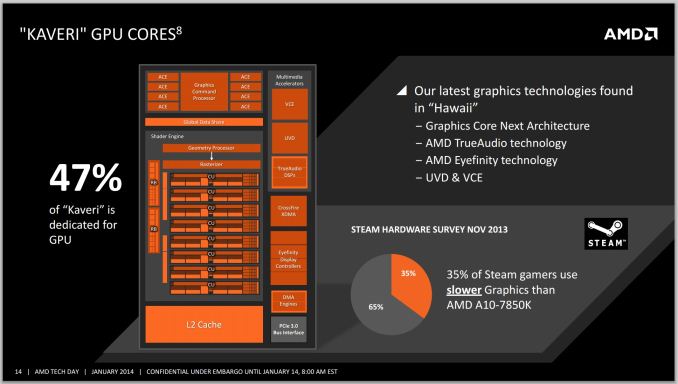
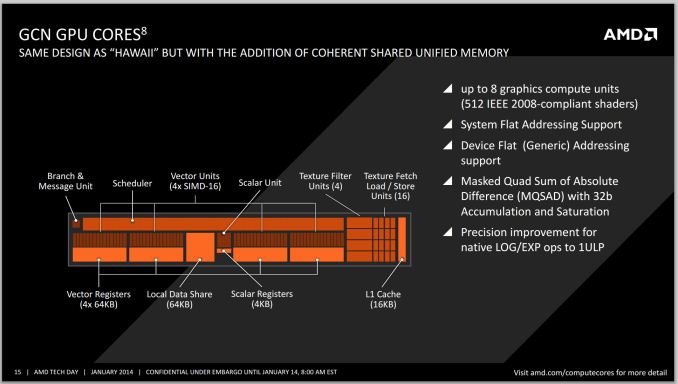
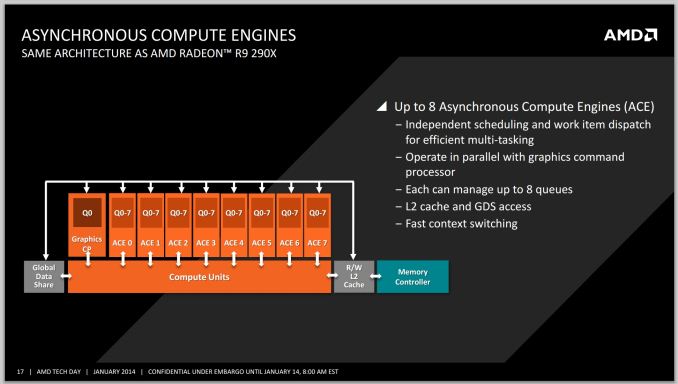
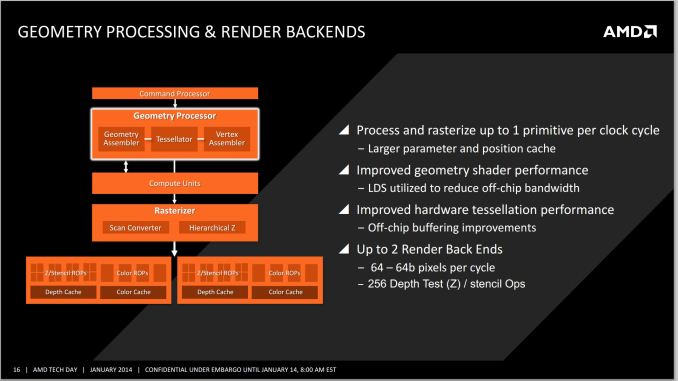
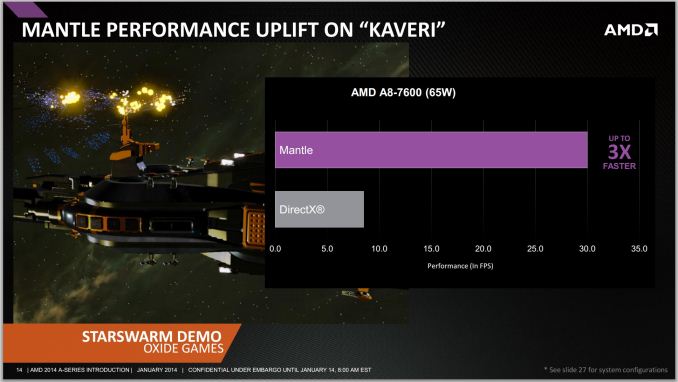
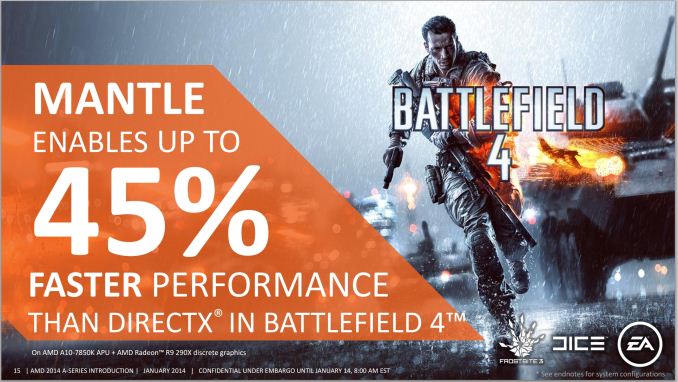
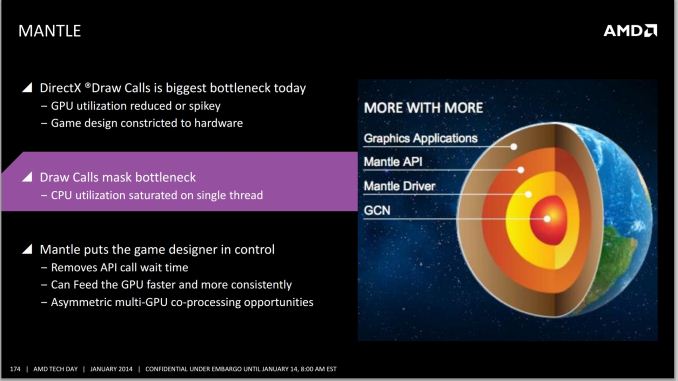
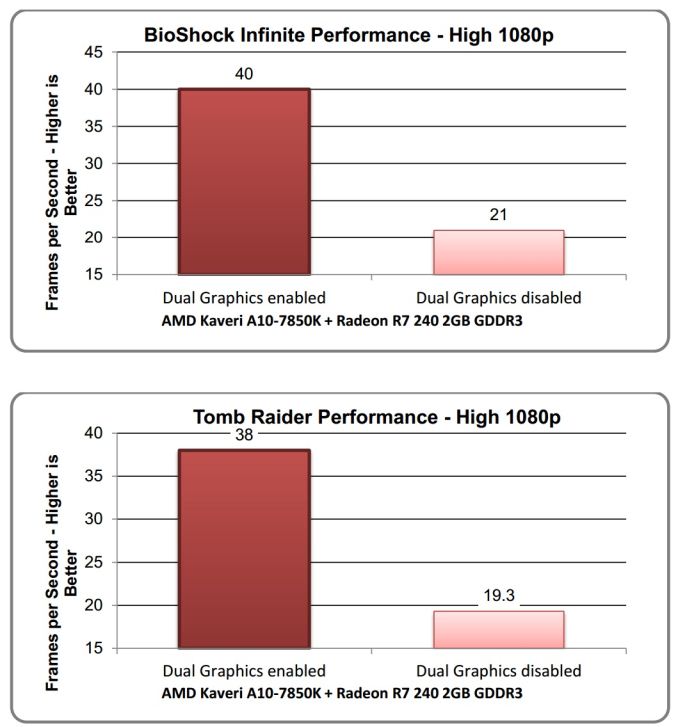
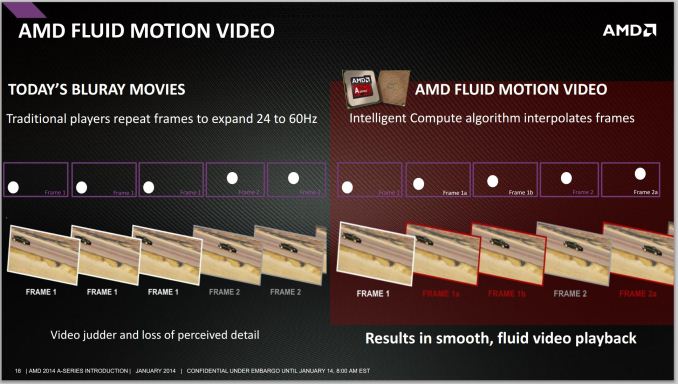








380 Comments
View All Comments
ImSpartacus - Thursday, January 16, 2014 - link
"Whether or not AMD decides to develop an APU with more than 8 GCN CUs is another matter. This is a point we've brought up with AMD internally and one that I'm curious about - do any AnandTech readers have an interest in an even higher end APU with substantially more graphics horsepower? Memory bandwidth obviously becomes an issue, but the real question is how valuable an Xbox One/PS4-like APU would be to the community."I would love to see a massive APU with a Pitcairn-sized GPU. I wouldn't mind if it required a 130-150+W TDP.
I love seeing machines like the 4770R-powered Brix Pro. Valve obviously likes it as well, because it became the Steam Box sent to developers.
If I'm getting the performance of a ~$200 GPU, I'd happily pay $300 to get the CPU baked in. I'm hoping DDR4 will allow Intel or AMD to pursue this kind of market.
Haravikk - Friday, January 17, 2014 - link
I'm really interested to find out what the dual graphics performance will be like now that AMD's APUs are much more up-to-date at long last.CrossFire using an APU and a discrete GPU has been entirely underwhelming thanks to how limited compatibility was, so much so that you are always better off fitting a better discrete GPU instead. The only case it remained interesting was for small form factors where the more limited range of low-profile cards (and less aggressive pricing) meant that compatible cards weren't always so far behind newer ones.
But with GCN graphics, HSA and Mantle on the way, maybe we might finally see the benefit of pairing the two rather than just using a better pure CPU and discrete graphics. Of course, we could see some benefit already if more games used OpenCL for physics, since that at least would run quite well on an APU even if the discrete GPU still did all the heavy graphical work.
Klimax - Friday, January 17, 2014 - link
Tests are very incomplete. Where are CPU+GPU results? AMD markets APU as total solution, so as such it should be tested. So far I have seen only Luxmark set of results on TechReport and when CPU+GPU was set, APU lost, because CPU part is sufficiently weak, that not even powerful GPU was able to save it.Also some OpenCL tests are not marked whether CPU+GPU or GPU-only, which can skew things badly.
eanazag - Friday, January 17, 2014 - link
I think this article is good, but it deserves and needs some dings on it because it is on Anandtech. When we look at the benchmark section there is a disconnect between this article (the applications used for benchmarking) and the Bench portion of the website. I have enjoyed and trusted the bench methodologies used on this site over the years and find it a resource I come back to, to help me make purchasing and hardware decisions because of the bench. Over time I will find it difficult to compare findings without the bench. I have no problem with you updating the bench as what has been done with SSDs and GPUs. I just think this article overlooked what becomes the real value of what this site offers if you overlook the ongoing bench portion of this site. I looked in the bench and haven't really seen a whole lot of anything recent on AMD APUs in the bench. That's my first ding.I suspect that if Anand was excited about AMD's release and had reviewed this product we would have gotten a better appreciation of what Kaveri brings to the table. I got the message that the 45W part is a very good in its segment and may be something worth considering, but I did not get what is mentioned in the article. What's the reality of running Kaveri on 1080p? You gave us the high settings, but no one with any sense is going to settle for less than 12 fps. So what are the realistic settings that will give us 20/30+ fps (game depending) performance. What are we really able to work with. I understand Anand is busy and likely not excited about another AMD CPU product release. I get it; it is hard to get excited about desktop and higher wattage laptop parts for AMD because they have been lack luster & underwhelming year over year for so long. I think this product fits in more than just the 45W space, but I didn't get that answer. I am still wondering, which is not what I would normally get at Anandtech. Normally, I would be getting more than I expected from a review. That's my second ding.
This next is a general ding about the bench. You guys do great work here. I am on here about every day. The bench could use some tweaking in relation to the CPU and GPU between laptop and desktop and to an extent mobile. I want to know how a mobile GPU/CPU matches up to a desktop variant. Sometimes I even want to know how they match up in mobile devices (tablets and phones). I have gotten some of that info from articles, but it is rough matching up that info in the mobile (laptop) bench. Sometimes I do want to look at specific laptop info, but most of the time I am just considering the guts of the device. I decide between the trade offs of desktops to laptops in applications. The information is here, but it is not easy to compare. This is an opportunity for improvement, especially given the nature of the changing technology landscape.
This is an addendum to the bench issue. I'd like to compare server processors too. It seems to me like in some niches we might start seeing server parts fill over the places where those highend desktop parts were. I already see this in AMD. Intel is on the cusp of this also. This is something to consider. I'd also like to see some more enterprise items covered in general. AMD is selling ARM servers already? Where have I been? And there are ARM based linuxes available.
Thanks for the great work and timely info.
HisDivineOrder - Saturday, January 18, 2014 - link
"The point I am making with this heart-warming/wrenching family story is that the Kaveri APU is probably the ideal fit for what he needs. Strap him up with an A8-7600 and away he goes. It will be faster than anything he has used before, it will play his games as well as that new HD 6750, and when my grandmother wants to surf the web or edit some older images, she will not have to wait around for them to happen. It should all come in with a budget they would like as well."OR you could buy him a cheapo dual-core CPU from Intel plus a used mid-range card from a year or two ago.
Far better performance for only a bit more. There is an argument forthese APU's in gaming and it's for those who want to game with something like a Gigabyte BRIX-sized computer that trades performance for size.
Performance per dollar does not favor the APU simply because you can get so much more performance ignoring these APU's altogether.
NinuGie - Saturday, January 18, 2014 - link
such wow much fail. until APU comes in desktop format there will always be better alternatives. i want to see an APU compact format and similar to what they did on PS4. shared fast RAM .until then,they suck. i mean this is so bad implemented. and they advertise it for gamers lol. even if you CF the apu with a supprted gpu ,a HD 7770 is better so no thank youarthur42 - Sunday, January 19, 2014 - link
The A10-6700T is in good supply in Europe; I'm running one for months now.aidnr - Monday, January 20, 2014 - link
I'm pretty impressed with what they've done here, it looks like it is pretty evenly matched with Intel's offering - http://versus.com/en/amd-a10-7850k-vs-intel-core-i...Will be interesting to see how widely adopted Mantle is, seems pretty nice.
samal90 - Monday, January 20, 2014 - link
Can someone explain to me how come AMD is able to make an incredible APU capable of running games at almost 60fps on the new consoles but can't make a desktop APU to do so? Why can't they use the same architecture? Maybe I'm missing something...but I'm just wondering.meacupla - Wednesday, January 22, 2014 - link
Because PS4/XB1 is not limited to using FM2+ socket, because they use a much slower CPU portion in PS4/XB1 and because of thermal limits.